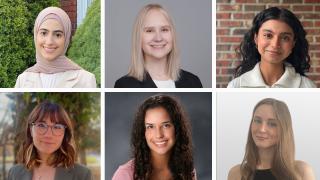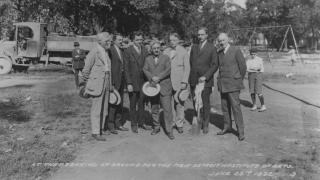
“I’m so much more comfortable ‘out there,’” she said. “I feel like there’s so much more to contribute.”
According to a recent university inventory, Roddy’s not the only one spending time “out there,” directly connecting with the community surrounding UM-Dearborn.
The university’s first Community Engagement Inventory revealed that faculty and staff reported nearly 32,000 hours of service to the community with 504 community partners.
The Integrated Learning and Community Partnership Office (ILCPO) conducted the research, led by Tracy Hall, director of community engagement, Carla Vecchiola, director of the Civic Engagement Project, and Tiffany Marra, director of integrated learning. Approximately 36 percent of faculty and staff members responded to the survey.
“Across campus, we talk about being an engaged campus, about having a metropolitan impact,” said Tracy Hall, director of community engagement. “We wanted to look at how, exactly, we’re having that impact.”
The survey gathered information about faculty, staff and student engagement activities, including conducting community-based research, doing volunteer work, serving on local boards or commissions, participating in professional and association activities, and engaging students in community-based activities.
According to Hall, the missions of the organizations supported by the work were as diverse as the makeup of campus, including education, the environment, social justice and economic development.
For Roddy, work revolves around health economics and substance abuse.
One day, she’s working with fellow professor Paul Draus, looking at the impact of grassroots efforts to revitalize a Detroit neighborhood; the next day, she and Draus are serving on a task force for citizens returning to the community after serving time in prison. She works with the director of a rehabilitation facility to infuse more academics into weekly lectures and enlists her students to dissect program evaluations.
“It all flows together. Students are involved in the research; the research ends up in the classroom,” Roddy said. “It’s a rich and rewarding experience.”
Molly Manley, research assistant for ILCPO, said Roddy exemplifies the spirit of faculty and staff on campus. “Many faculty and staff members are involved in more than one type of community activity,” she said.
That involvement trickles down to students—through Academic Service Learning classes, Community Involvement and Volunteerism Center (CIViC) programs and student organization projects.
The CIViC recruited 643 volunteers totaling 2,743 hours of service, while student organizations reported 340 student volunteers totaling 3,714 service hours.
The results of the inventory will help ILCPO provide better resources to faculty and staff hoping to partner with community organizations.
“We know we’ve just scratched the surface with this initial inventory,” Hall said. “Here’s our base. Now how do we grow our base and encourage engagement?”
The goal, she said, all points back to the university’s mission. “With our metropolitan vision, UM-Dearborn wants to go beyond just helping students ‘get jobs. We want our graduates to be contributors to their community and help transform this region.”




